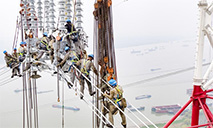Xiconomics: China's steady economic growth adds certainty to global development
BEIJING, March 23 (Xinhua) -- Amid profound changes unseen in a century, the global economy is experiencing a weak and uneven recovery, and the world is calling for practical actions to re-energize the global economy and drive it forward.
Under the guidance of "Xiconomics," the economic philosophy of Chinese President Xi Jinping, China has been working steadily to prop up the real economy, strengthen its innovation capacity and enhance practical cooperation with the rest of the world, which has further consolidated the foundation of the country's economy and improved its anti-risk capacity.
China's solid growth has not only served as a stabilizer and a driving force for the world economy, but has offered other countries inspiration for reviving economies, boosting development and achieving strong and sustainable growth.
With a strong focus on production, manufacturing and innovation, Xi's economic thought injects impetus into global growth that is wrestling with numerous uncertainties.
STRONG SUPPORT FOR REAL ECONOMY
"The real economy is the foundation of a country's economy and source of wealth. Advanced manufacturing is one key area of the real economy and the economic development cannot be separated from the real economy at any time," Xi said during his inspection tour of China's southern Guangdong Province back in 2018.
The Chinese president, on many occasions, has highlighted the importance of supporting the real economy, setting a clear direction for China's economic development and enlightening the international community about global growth. His thoughts bear a special significance against the backdrop of the ravaging COVID-19 pandemic.
In the early months after the onset of the pandemic, many Chinese companies, including carmakers and energy enterprises, have transformed their businesses to cater to the surging demands both at home and abroad for anti-virus products including masks and disinfectants, contributing to the stable operation of global supply chains.
These have reflected the different roles the real economy plays in China and Western countries, overseas observers have said.
As the world's largest manufacturing country, the top trader of goods, as well as the second largest consumer of goods, China has contributed over 30 percent to global economic growth in recent years, and withstood the tough test brought about by the pandemic.
Under Xi's leadership, China has emerged as the only major economy with positive growth in 2020, a demonstration of the vitality and resilience of the country's economy amid the global public health crisis. In 2021, China's gross domestic product saw a year-on-year increase of 8.1 percent, exceeding 110 trillion yuan (17.3 trillion U.S. dollars) and beating most market expectations.
Being estimated to account for over 18 percent of the global economy in 2021, China's economy is in an increasingly prominent position in world development.
Wichai Kinchong Choi, senior vice president of the leading Thai bank Kasikornbank, told Xinhua that China has played a crucial and irreplaceable role in supporting the global supply chain.
"China's comprehensive advantages, such as the vast and promising market, abundant human resources, sound infrastructure and complete industrial facilities, all make it attractive to foreign investment," the banker said.
ENHANCING INNOVATION CAPACITY
"A new round of technological revolution and industrial transformation is gathering pace, and science and technology are playing an even more significant role in boosting social productivity," said Xi while delivering a keynote speech via video at the APEC CEO Dialogues in 2020.
Thanks to Xi's deep insight into the changes in different stages of development, China has been firmly implementing its new development philosophy featuring innovative, coordinated, green, open and shared growth, and working to shift its growth model, contributing China's wisdom and strength to global economic transformation and development.
Located on a hill-surrounding steppe near the city of Zhanatas in the Zhambyl Region in southern Kazakhstan, a Chinese-built wind farm, the biggest one in Central Asia, stands as a living embodiment of how Chinese innovation has improved the lives of local people. The project have not only alleviated Kazakhstan's power shortage, but also increased local tax revenue.
From "made in China" to "created in China," the country is stepping up its pace toward the middle and high-end of industrial and value chains. In February, China's Hualong One, a domestically designed third-generation nuclear reactor, was confirmed adequate for use in Britain, which is of vital importance for the island country to make up for its energy shortage and shore up its economy.
Meanwhile, China is taking the lead in the field of integrating digital economy with the real economy. Relying on such new technologies as cloud computing, e-commerce and fintech, China is playing an active role in facilitating regional and global trade.
In Southeast Asia, the joint construction of "a digital Silk Road" keeps gaining fresh momentum as China and the Association of Southeast Asian Nations (ASEAN) have been expanding their cooperation in such emerging fields as smart city, 5G and big data.
According to ASEAN Secretary-General Lim Jock Hoi, with the thriving digital cooperation between China and ASEAN, the regional bloc's digital economy is projected to increase from 1.3 percent of its gross domestic product in 2015 to 8.5 percent in 2025.
China, a country striving to step up its innovation and pursue high-quality development, will for sure create more opportunities for cooperation and bring about more tangible benefits to others.
STRENGTHENING PRACTICAL COOPERATION
Looking at the newly-built bridge spanning across the Mekong River, Da Danuch, a 31-year-old civil servant in Cambodia, could hardly hold back her excitement.
"Previously, it took at least one hour to one hour and a half to cross the river by ferry, but it's convenient now because we have the bridge, and it takes less than five minutes to cross the river," she said.
The Chinese-built Stueng Trang-Kroch Chhmar Cambodia-China Friendship Bridge came into service in late 2021, which has largely facilitated transportation and businesses between the two sides of the river. It is an important achievement within the framework of the Belt and Road Initiative, and also exemplifies China's commitment to deepening practical cooperation with the rest of the world for joint development.
Cooperation between China and its partners has not only upgraded local infrastructure and improved the skills of workers, but also advanced cultural and people-to-people exchanges.
In a classroom in Guinea-Bissau in West Africa, students raised their hands, competing for chances to answer questions from Chinese agricultural technicians.
It was an agricultural machinery skills training class taught by a team of Chinese technical experts. Over the past two decades, Chinese expert teams have trained more than 22,000 people there with technical skills, in a big boost to the country's agricultural development.
"China will promote high-quality Belt and Road cooperation so that more countries and peoples will benefit from its development opportunities and real outcomes," Xi said at the opening ceremony of the fourth China International Import Expo in November 2021. His remarks demonstrated China's sincere readiness to share the fruits of development with countries around the world.
Under the guidance of Xiconomics, China is pursuing growth while ensuring stability, and expanding practical cooperation with its partners to bring benefits of its development to countries across the globe, which has injected confidence into the world economy.
Photos
Related Stories
- Chinese Wisdom in Xi's Words: "A just cause should be pursued for the common good"
- Interview: Xi-Biden video call matters to China-U.S. relations -- pundit
- Xi Focus-Quotable Quotes: Xi Jinping on conservation of water resources
- Xi Jinping on conservation of water resources
- Why China's vision for development can help promote global prosperity
Copyright © 2022 People's Daily Online. All Rights Reserved.










